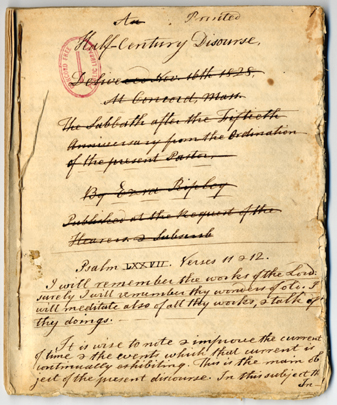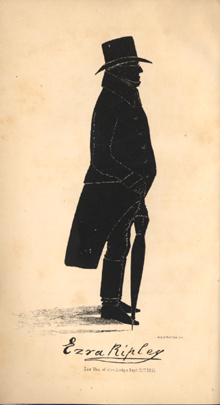Top to bottom: 6, 7, 8 and 9.
   
|
EZRA RIPLEY
6. Ezra Ripley. Holograph manuscript of Half Century Discourse, 1828. Ink on paper; stitched. 7. Ezra Ripley. Half Century Discourse, Delivered November 16, 1828, at Concord, Massachusetts (Concord: Printed by Herman Atwill, 1829). Letterpress on paper; stitched. Edward Jarvis’s copy, with manuscript inscription on title-page. 8. Frontispiece silhouette of Ezra Ripley, from By-Laws of Corinthian Lodge, of Ancient, Free and Accepted Masons (Concord: Benjamin Tolman, 1859). 9. Ralph Waldo Emerson. [Obituary of Ezra Ripley.]
Piece in the Concord Republican for October 1, 1841. Letterpress
on paper. Myerson E34.
Ezra Ripley—minister in Concord for a remarkable sixty-three years, from 1778 to 1841—was born in 1751 in Woodstock, Connecticut, fifth of the nineteen children of Noah Ripley (a descendant of William Ripley, an original settler of Hingham) and Lydia Kent Ripley. He entered Harvard College in 1772, spent time in Concord when the college was temporarily moved here in 1775, graduated in 1776, and was ordained minister of the First Parish in 1778. In 1780, Ripley married Phebe Bliss Emerson, widow of his predecessor William Emerson and daughter of Emerson’s predecessor Daniel Bliss. Living in the Manse, the couple raised William Emerson’s children (with the exception of Mary Moody Emerson, who was raised by relatives) and three of their own (Samuel, born in 1783; Daniel Bliss, 1784; and Sarah, 1789). Ripley’s senior by eleven years, Phebe died sixteen years before her second husband. Patriarch though Ezra Ripley was, he was loved as well as respected in Concord, known as a good if sometimes harsh man, generous, sociable, fond of company and conversation, and partial to the ladies. He was a member of the Social Circle in Concord and also of the Corinthian Lodge of Freemasons. In a brief biographical sketch of Ripley in By-Laws of Corinthian Lodge (1859), Louis Surette wrote: “Indeed he was himself a king in his own parish, but one who ruled for the good of his subjects, and deserved and earned their love as well as their awe.” During Ripley’s long ministry, the First Parish gradually grew away from its original Congregational Calvinism and toward Unitarianism. Although not antagonistic to the liberalization of his church, Ripley remained old-fashioned in his attachment to the forms and observances of traditional religion. In his Social Circle biography of his step-grandfather, Ralph Waldo Emerson wrote: “He was identified with the ideas and forms of the New England church, which expired about the same time with him, so that he and his coevals seemed the rear guard of the great camp and army of the Puritans, which, however in its last days declining into formalism, in the heyday of its strength had planted and liberated America. It was a pity that his old meeting-house should have been modernized in his time. I am sure all who remember both will associate his form with whatever was grave and droll in the old, cold, unpainted, uncarpeted, square-pewed meeting-house … ” First Hersey Goodwin and then Barzillai Frost served as Ripley’s junior colleagues during the final decade of his ministry. Emerson’s Social Circle biography—a respectful, perceptive, character sketch revealing Emerson’s personal feeling for Ripley—was based on the long, close relationship between the two. Emerson wrote of the combination of severity and kindness in Ripley’s character, of his sincerity, practicality, sympathy with his fellow man, generosity, habit of speaking to the point of any subject, rich store of anecdotes, affectionate nature, and consistency. He also noted Ripley’s credulity, his tendency to be opinionated, and the limits of his reading and interest in intellectual inquiry. Emerson was impressed by Ripley’s intimate knowledge of Concord, its people, and its past. He recalled Ripley driving him about Concord during his childhood visits and telling him stories of the families who lived here. Ezra Ripley was particularly interested in the Concord Fight of 1775. Emerson described him as “a browbeater of the poor old fathers who still survived from the 19th of April, to the end that they should testify to his history as he had written it” (A History of the Fight at Concord, 1827). When Ripley died in 1841, Emerson wrote an obituary for the October 1, 1841 issue of the Concord Republican, which he later expanded into his Social Circle memoir.
No image in this online display may be reproduced in any form, including electronic, without permission from the Curator of Special Collections of the Concord Free Public Library.
Previous Entry - Back to Section I Contents Listing - Back to Exhibition Introduction - Back to Exhibition Table of Contents |